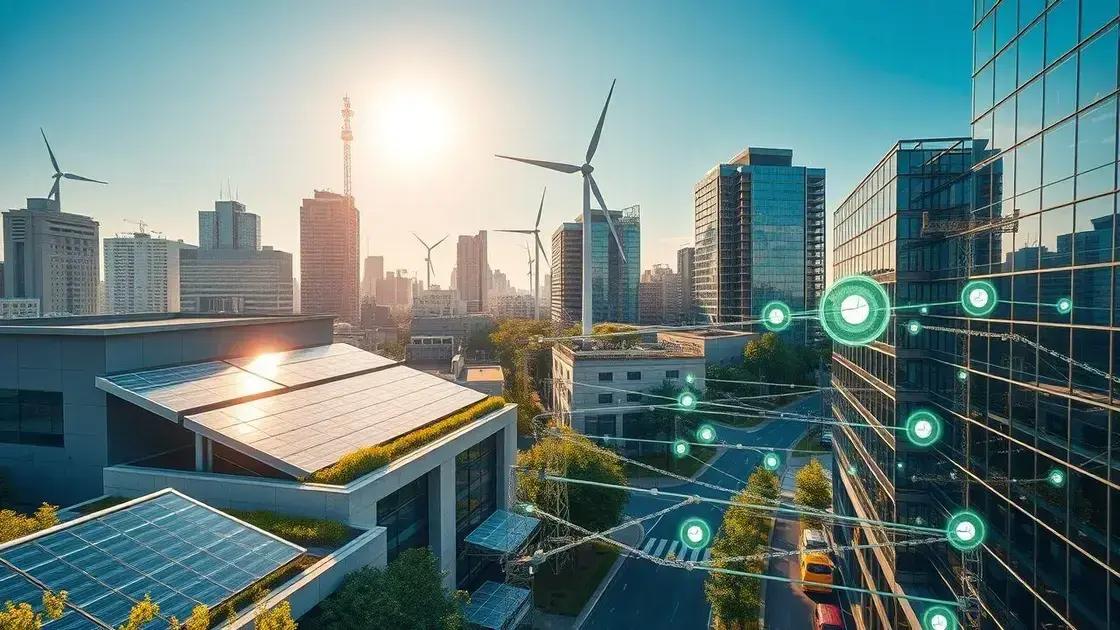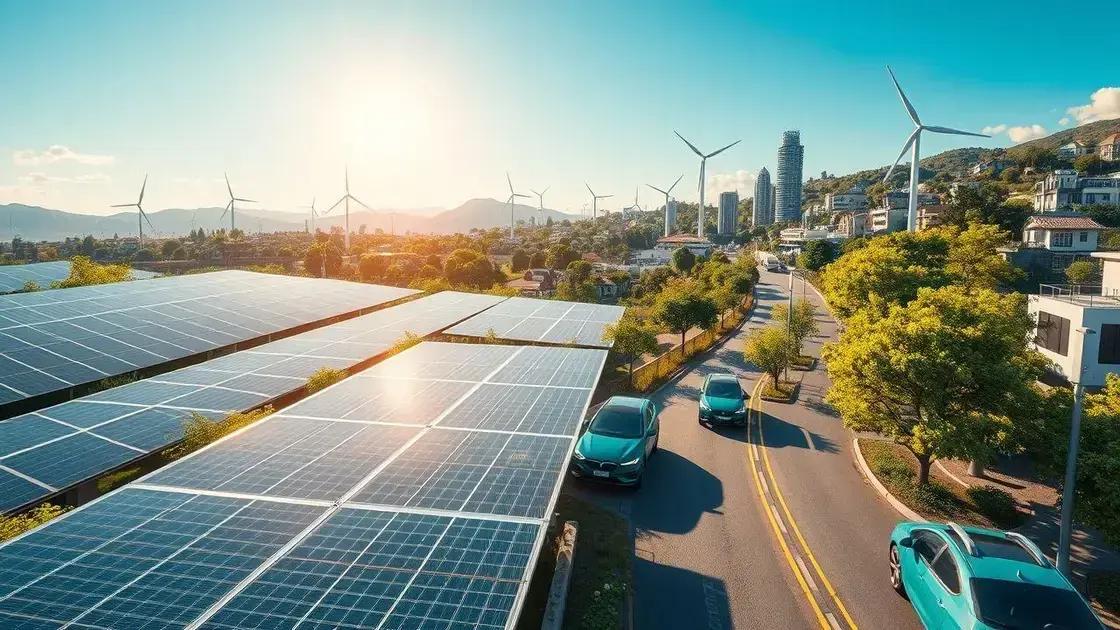Renewable energy expansion trends: what you need to know

Renewable energy expansion trends reflect a significant shift towards solar and wind energy, driven by technology advancements, government policies, and increasing public awareness, addressing climate change and promoting sustainability.
Renewable energy expansion trends are not just buzzwords; they’re reshaping the way we think about energy consumption. Have you ever considered how these shifts affect your daily life?
Current global renewable energy trends
Current global renewable energy trends show an exciting shift in how we generate and consume energy. Understanding these trends can help us make better choices for our planet and our future.
One major trend is the increase in solar energy adoption around the world. Countries are investing heavily in solar farms, which harness the sun’s energy. This shift is not only sustainable but also cost-effective. Governments and businesses are realizing the benefits of going green.
Wind Energy as a Leading Force
Alongside solar energy, wind energy is also gaining traction globally. Wind turbines are popping up in more locations, providing clean energy to many areas. This trend is crucial for diversifying our energy sources.
- Wind farms are providing job opportunities in many regions.
- Technological advancements are making wind energy extraction more efficient.
- Countries are setting ambitious wind energy goals for the future.
Another vital trend is countries committing to net-zero emissions by 2050. This goal has led to increased investments in renewable resources. Nations are collaborating to create policies that support this transition.
The Role of Policy and Innovation
Policies play a significant role in shaping renewable energy trends. Incentives for clean energy projects can accelerate growth. Additionally, innovations like energy storage solutions help manage energy supply and demand.
- New battery technologies are key for storing renewable energy.
- Smart grids enhance efficiency and reliability.
- Research is continuously improving renewable energy technologies.
As we observe these renewable energy trends, it’s evident that the world is heading toward a more sustainable future. The shift to renewables not only mitigates climate change impacts but also fosters economic growth.
Key technologies driving renewable energy

Key technologies driving renewable energy are transforming how we generate and use power. These innovations are essential for creating a sustainable future.
One of the most significant technologies is solar photovoltaic (PV) systems. These systems convert sunlight directly into electricity. As the cost of solar panels decreases, more homes and businesses are adopting this technology.
Advancements in Wind Energy
Wind turbines are another crucial player in the renewable energy landscape. By harnessing wind power, they provide clean energy to millions. New designs are making these turbines more efficient and less intrusive.
- Horizontal-axis wind turbines are the most common type.
- Vertical-axis wind turbines are becoming popular due to their design flexibility.
- Offshore wind farms are gaining momentum for their potential to generate large amounts of energy.
Energy storage technologies, like lithium-ion batteries, are vital for storing the energy generated by renewables. They allow us to use that energy when the sun isn’t shining or the wind isn’t blowing. As battery technology continues to improve, storage efficiency is also increasing.
Smart Grid Technologies
Smart grids play a significant role in integrating renewable energy sources into our electricity supply. They use digital technology to enhance the reliability and efficiency of electricity distribution. This innovation helps to balance demand and supply, making the energy network more resilient.
- Smart meters provide real-time data on energy usage.
- Demand response programs encourage users to reduce consumption during peak periods.
- Distributed generation allows for local energy production, reducing reliance on central power plants.
As we embrace these key technologies, the transition to renewable energy becomes increasingly feasible. The collective impact of these innovations is paving the way for a cleaner, more sustainable future.
Challenges in renewable energy adoption
Challenges in renewable energy adoption are significant hurdles that many countries face as they strive for a sustainable future. Understanding these challenges helps stakeholders navigate the transition more effectively.
One major challenge is the initial cost of renewable energy technologies. Solar panels and wind turbines require substantial investment upfront. Although long-term savings are evident, the initial financial barrier can deter many individuals and businesses.
Grid Integration Issues
Another critical challenge involves integrating renewable energy sources into the existing power grid. Current grids are often outdated and not designed to handle the variable output from sources like solar and wind. This requires upgrades to ensure stability and reliability.
- Grid flexibility is essential to accommodate fluctuations in supply and demand.
- Smart grid technologies can facilitate better management of renewable energy.
- Infrastructure investments are needed to enhance grid capacity for renewables.
Regulatory barriers also impede the growth of renewable energy. Inconsistent policies and incentives across regions can cause confusion for investors. Clear, stable policies are needed to encourage growth in the renewable sector.
Public Perception and Awareness
Public perception plays a significant role in renewable energy adoption. There are often misconceptions about the reliability and efficiency of these technologies. For instance, some people may believe that renewable energy is not as dependable as fossil fuels.
- Education campaigns can help inform the public about the benefits of renewables.
- Success stories can illustrate the practical applications of renewable technologies.
- Community engagement is crucial to dispel myths and build support.
As we address the challenges in renewable energy adoption, we pave the way for a cleaner, more sustainable energy landscape. Overcoming these obstacles will require a collaborative effort from governments, businesses, and communities.
Future predictions for renewable energy growth

Future predictions for renewable energy growth are essential as we look to build a sustainable world. Analysts are optimistic about the direction of renewable energy as technology continues to evolve.
One exciting prediction is the significant increase in solar and wind energy capacity. Many experts believe these sources could dominate the global energy supply within the next few decades. In fact, solar power is expected to become one of the most cost-effective energy sources available.
The Rise of Electric Vehicles
Another factor contributing to growth is the rise of electric vehicles (EVs). As more consumers adopt EVs, the demand for renewable energy will increase. This trend pushes utilities to invest in clean energy sources to meet rising demand.
- Increased charging infrastructure will support EV adoption.
- Government incentives are encouraging consumers to choose electric cars.
- Manufacturers are rapidly expanding their electric vehicle offerings.
Additionally, innovations in energy storage are paving the way for a stable renewable energy future. Improved battery technologies allow us to store excess energy for use during peak times. As these technologies mature, they will facilitate a more reliable energy supply.
Policy and Investment Trends
Government policies are also evolving to support renewable energy growth. Many nations are setting ambitious targets for reducing greenhouse gas emissions. These policies often include incentives for renewable energy projects, making it easier for businesses to invest.
- Global commitments, like the Paris Agreement, are driving change.
- Investment in clean energy projects is increasing significantly.
- Public awareness is leading to greater support for green initiatives.
As we consider the future predictions for renewable energy growth, it’s clear that a shift toward cleaner energy is inevitable. Embracing these changes will help us create a more sustainable and resilient energy landscape for generations to come.
In conclusion, the future of renewable energy is bright and full of potential. With advancements in technology, strong government support, and rising public awareness, we are likely to see substantial growth in solar, wind, and other clean energy sources. It’s essential to overcome challenges like integration and initial costs so that we can fully embrace this shift. By doing so, we can create a sustainable future for ourselves and generations to come.
FAQ – Frequently Asked Questions about Renewable Energy Growth
What are the main sources of renewable energy?
The main sources of renewable energy include solar, wind, hydroelectric, geothermal, and biomass.
Why is renewable energy important?
Renewable energy is important because it reduces greenhouse gas emissions, decreases reliance on fossil fuels, and helps combat climate change.
What challenges does renewable energy face?
Challenges include high initial costs, grid integration issues, regulatory barriers, and public perception.
How can individuals support renewable energy growth?
Individuals can support renewable energy by using solar panels, choosing green energy suppliers, and advocating for clean energy policies in their communities.





